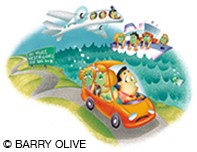Peer Reviewed
Feature Article Travel medicine
Motion sickness: a guide to prevention and treatment
Abstract
A GP can be a helpful source of advice for dealing with this common problem. Appropriate management takes into account the length of the trip, the severity of the stimulus and the individual’s susceptibility, and includes not only pharmacological treatment but also general measures to minimise the sickness.
Key Points
- Prolonged motion sickness is associated with malaise, anxiety, depression, apathy and a decrease in attention and concentration; however, most individuals will adapt to prolonged stimulus and experience complete recovery in three to four days.
- The prevalence of motion sickness is related primarily to the severity of the stimulus and the susceptibility of the individual.
- General measures to minimise the individual’s reaction include: eating small, infrequent, low kilojoule meals before and during travel; focusing on a fixed point outside the vehicle or closing the eyes when this is not possible; reducing head movements; engaging in a mental activity or task.
- Hyoscine and antihistamines are the drugs of choice in the prevention and treatment of motion sickness.
- The efficacy and side effects of different drugs vary greatly from one individual to another, therefore if one drug is ineffective or not well tolerated it is useful to try another.
Purchase the PDF version of this article
Already a subscriber? Login here.

